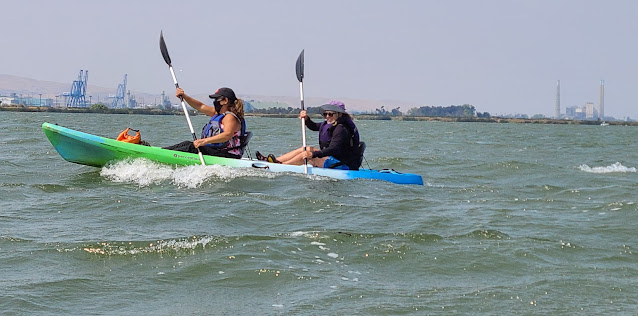 |
| Book tours, classes and rentals here. |
Saturday, December 10, 2022
Cold Weather Paddling
Tuesday, February 15, 2022
Wind and Waves
As winter comes to a close and spring approaches, it won't be long before our seasonal winds pick up in the Delta and the San Francisco Bay Area. With that in mind I thought I would write about how to plan and be prepared for these conditions or how to avoid them altogether.
In general, the wind tends to pick up in March and continue through August. Not every day is windy but it can sometimes feel like it. Knowing how to understand wind and tide predictions will make your paddling adventures so much more fun and help to keep you safe. I instruct my students who are just beginning their paddling endeavor to avoid paddling in winds above 10 mph. Many paddlers are capable of paddling in higher winds but as a general rule I suggest not paddling in winds above 15 mph unless you are proficient with self and assisted rescues and have practiced those rescues in those conditions.Spring and summer winds in our area are typically northwesterly, which means the wind blows from that direction. A benign day can become challenging or even treacherous when that wind opposes the direction of the current or direction the water is moving. It's important to know what the tide will be doing before getting on the water. Many locations in the Delta can experience 5 to 6 foot swells and breaking waves when the wind is blowing 10-15 mph against a big outgoing tide. These can be fun conditions especially if you enjoy surfing but can be scary for beginners and even intimidating for intermediate paddlers. Shallow water areas or shoals can also experience confused seas and breaking waves with relatively low wind speed.The wind we experience in the Delta is generally stronger than the currents so I suggest paddling against the wind to begin your paddle so you'll have it at your back on the way home when you may be tired. Here are some steps to take to plan your next paddling adventure:
1) Check tides and know that in our area that it takes another 2 hours for the river to change direction.
2) Check wind forecast and be prepared to change your mind at the put in. Wind forecasts have been known to not be precisely accurate. You can also monitor the wind and weather forecast using a VHF radio and a VHF radio is great to have in case of emergency.
3) Check nautical charts or maps to plan your trip and note potential emergency exit points or places you can shelter from wind.
4) Make sure to dress appropriately for water temperature, wear your PFD and bring safety gear such as whistle, two forms of communication, spare paddle, bilge pump and paddle float if using a sea kayak.
5) Create a float plan and do not deviate from it unless you notify your emergency contact that you are changing times and or locations and or destinations
6) Make sure the equipment you are using is appropriate for where you are paddling. Recreational type kayaks with no bulkheads or only one bulkhead should be equipped with float bags so the vessel can not sink. If using this type of craft never paddle far from shore.
To avoid windy conditions altogether, look for protected areas to paddle. Smaller sloughs or channels and many of the tributaries of the Sacramento and San Joaquin rivers are amazing places to paddle.
The above information is a brief synopsis of how to decide on whether to paddle in windy conditions. There is so much more to learn and know about tides, currents, weather and trip planning. Contact Delta Kayak Adventures to learn more about how we can help you become a better, safer paddler by joining some of the classes offered. We offer private and group lessons and tours year round.
The following video is an excellent visual resource to see how wind and current effect each other.






